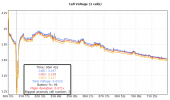I understand the minimum operating temperature of the Mavic Air 2 is 14°F (-10°C) per page 47 of the v.1.4 user manual.
Where I live it is forecast to get down to -17°F (-27°C) in the next few days.
I have successfully flown my MA2 with a surface temperature of 5°F (-15°C) in clear skies to avoid propeller ice. I started with a 68°F (20°C) battery to avoid power issues and the battery temperature surprisingly INCREASED to 77°F (25°C) by the end of the 20 minute flight. I do not expect any issues flying in even colder temperatures.
What is the coldest temperature you have successfully flown in? I'm curious to hear any first hand experience flying in close to -17°F (-27°C) weather. Cheers!
Where I live it is forecast to get down to -17°F (-27°C) in the next few days.
I have successfully flown my MA2 with a surface temperature of 5°F (-15°C) in clear skies to avoid propeller ice. I started with a 68°F (20°C) battery to avoid power issues and the battery temperature surprisingly INCREASED to 77°F (25°C) by the end of the 20 minute flight. I do not expect any issues flying in even colder temperatures.
What is the coldest temperature you have successfully flown in? I'm curious to hear any first hand experience flying in close to -17°F (-27°C) weather. Cheers!
Last edited:













